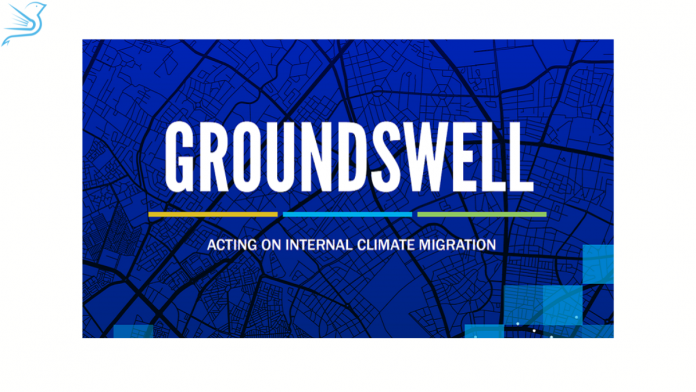The World Bank’s updated Groundswell report was released on September 13, 2021. The report indicated that climate change could force 216 million people across six world regions to move within their countries by 2050.
ABOUT THE REPORT
The First Groundswell Report: It was released in 2018 and focused on three regions: Sub-Saharan Africa, South Asia, and Latin America. It used a robust and new modelling approach to determine the extent, trajectory, and geographic patterns of future climate migration within countries.
The Second Groundswell Report: It builds on the first by focusing on three new regions: the Middle East and North Africa, East Asia and the Pacific, and Eastern Europe and Central Asia.
There are additional qualitative analyses of climate-related mobility in the Mashreq (i.e. the eastern half of the Arab World) and Small Island Developing States (SIDS).
The updated report includes projections and analysis for three regions: East Asia and the Pacific, North Africa, and Eastern Europe and Central Asia. It builds on the novel and pioneering modeling approach of the previous World Bank Groundswell report from 2018, which covered Sub-Saharan Africa, South Asia, and Latin America.
KEY HIGHLIGHTS OF THE REPORT
Internal Climate Migrants:
- As many as 216 million people could be internal climate migrants across the six World Bank regions (by 2050).
- Those regions are Latin America; North Africa; Sub-Saharan Africa; Eastern Europe and Central Asia; South Asia; and East Asia and the Pacific.
- By 2050, sub-Saharan Africa could see as many as 86 million internal climate migrants; east Asia and the Pacific, 49 million; south Asia, 40 million; north Africa, 19 million; Latin America, 17 million and eastern Europe and Central Asia, five million.
Most Vulnerable Region:
- Sub-Saharan Africa: Due to desertification, weak coasts, and the population’s reliance on agriculture, this region is the most susceptible and will see the most migrants.
- North Africa: It is expected to be home to the greatest number of climate migrants (9 percent ). This is largely owing to acute water constraint, as well as the effects of rising sea levels on heavily populated coastal areas and the Nile Delta.
- South Asia: In South Asia, Bangladesh is particularly affected by flooding and crop failures, accounting for almost half of the predicted climate migrants, with 19.9 million people, including an increasing number of women, moving by 2050.
RECOMMENDATIONS
The report provides a series of policy recommendations that can help slow the factors driving climate migration and prepare for expected migration flows, including:
Reduce Emission:
Reducing global emissions and making every effort to meet the temperature goals of the Paris Agreement. Five years after the Paris Agreement, the world is still headed for at least 3°C of warming by 2100.
Plan for Each Phase of Migration:
Planning for internal climate migration includes taking into account all stages of migration, including those that occur before, during, and after the move.
Adapt-in-place solutions can help communities stay put where local adoption choices are practical and sensible before they migrate. People who need to migrate away from unavoidable climatic threats can benefit from policies and investments that promote mobility during relocation. Planning can ensure that both the sending and receiving communities are well equipped to meet the requirements and ambitions of their respective populations after migration.
Embedding internal climate migration:
Integrating internal climate migration in development planning is critical to address the poverty factors that make people particularly vulnerable to climate change impacts, such as a lack of viable livelihood options and lower quality assets.
Internal climate migration should be embedded in far-sighted green, resilient, and inclusive development planning.
Investments:
To better contextualise and comprehend internal climate migration at the regional and country level, more investments in large-scale research are needed, including new, more granular data sources and differentiated climate change impacts.
People who need to migrate away from unavoidable climatic threats can benefit from policies and investments that promote mobility during relocation.
Planning can ensure that both the sending and receiving communities are well equipped to meet the requirements and ambitions of their respective populations after migration.
With this we come to the end of this blog. Stay tuned for more updates.




